Fairfax’s Peter Martin today notes that Prime Minister Malcolm Turnbull is planning to spend up big on urban infrastructure projects in a bid to drive an economic boom in Australia’s CBDs, which he argues are the ‘engine rooms’ of the economy:
While the media has been obsessing about tax, Malcolm Turnbull has been focused on setting Australia up. To do it, he’ll need to borrow big sums of money for exceptionally long periods at extraordinarily low interest rates…
What will Turnbull want the money for?..
Turnbull believes the next boom will also require physical investment. If it’s the result of people providing services in fields such as finance, law, health and others not dreamt of, you may think it requires little more than people, a good education system and the phone system or national broadband network to bring them together.
The Grattan Institute finds that workers in the Melbourne CBD (including Docklands and Southbank) typically produce $87 an hour, much more than the Melbourne-wide average of $53. Workers in the Sydney CBD produce $100 an hour, much more than the Sydney-wide average of $61. The combined CBDs of these two cities alone – a landmass of just 7.1 square kilometres – accounts for nearly 10 per cent of Australia’s production, three times what’s produced by agriculture.
Turnbull quotes economist Edward Glaeser, who wrote Triumph of the City, to make the point that cities are our greatest invention…
Getting more people into cities boosts the Australian economy, boosts incomes and boosts government revenue. Which is where the budget comes in…
Turnbull is prepared to spend more, so long as it can be rigorously demonstrated that the project will pay dividends…
States talk about capturing value, then chicken out. They don’t like offending the locals. Turnbull wants to give them cover. By insisting that they won’t get anything unless they grab some of the proceeds for themselves (and perhaps for the Feds) he’ll allow them to say he made them do it.
For years I have been an outspoken campaigner for increased infrastructure investment, provided it is based on sound selection and approval processes and would likely deliver net benefits to the economy. In fact, with Australia running a high immigration policy, I have argued that without such investment, living standards will plummet. I have also lobbied hard for a broad-based land tax, which would capture some of the uplift in land values from infrastructure investment.
So I have no issue with increasing infrastructure investment per se.
What I do take issue with is the suggestion that the CBDs are the engine rooms of the Australian economy, and therefore we should dedicate more resources to ensure their ongoing dominance.
The primary reason why Australia’s cities – particularly Sydney and Melbourne – contribute the largest shares of economic activity and highest wages is because they are home to Australia’s FIRE economy (finance, insurance and real estate), whose activity has exploded on the back of Australia’s record high mortgage debt and inflated housing market, as well as compulsory superannuation (see below charts).
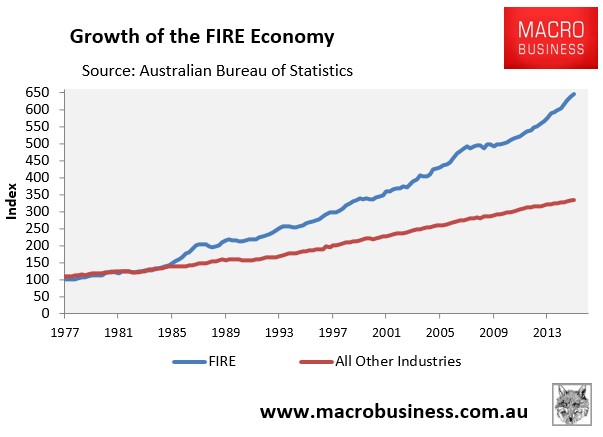
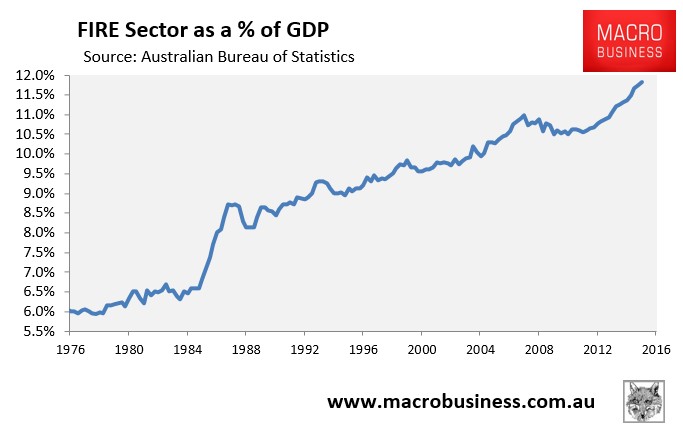
The rapid growth in the FIRE economy has come about through deliberate government policies, including tax lurks such as negative gearing and capital gains tax concessions, as well as urban consolidation policies, which have inflated land/house values and household debt. Compulsory superannuation has also driven resources to the funds management industry primarily operating out of Sydney and Melbourne. The high immigration policy, which has flooded the major cities with workers/consumers has also helped. In each case, economic rents have been transfer to the CBD from elsewhere.
But is this outcome desirable, sustainable and should it be celebrated? Many, including me, would argue that the financial sector is now far too large and is in fact a parasite that has created structural imbalances and damaged Australia’s longer-run productivity. One need only look to the share market where banks make up 40% of the bourse (down from half) to see the imbalance.
Would Australia really be worse-off if the median house price was $300,000 rather than $600,000, mortgage debt was 65% of disposable incomes instead of 133%, and the banking sector was smaller and less profitable? In a similar vein, would the nation be worse-off if superannuation concessions had been much smaller and didn’t favour high income earners, and the funds management industry was smaller and less profitable? The answer is obviously no. And yet economic rents accruing to the CBD’s would be lower under each scenario.
The article also fails to acknowledge that rural and regional areas provide Australia with not only its food, but also the lion’s share of its export revenue, which is effectively what pays for Australia’s imports (consumed mostly by the wondrous “city”):
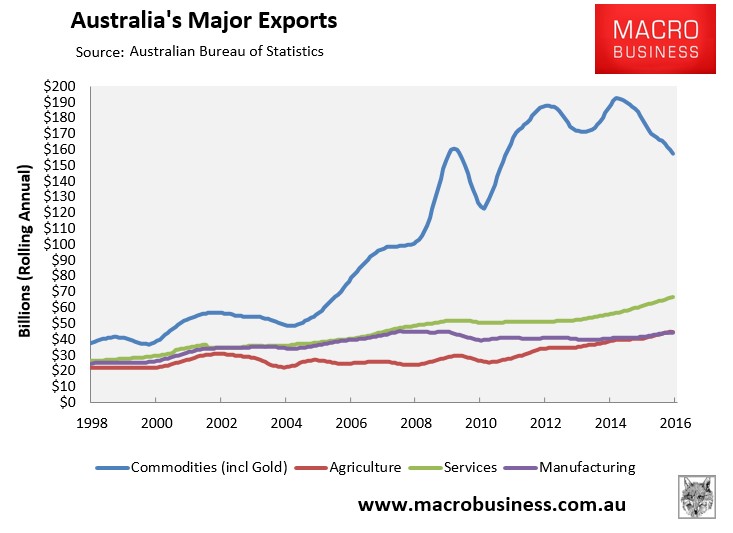
We see this also in income data. If the cities are such big economic engines, then why has Australia’s national disposable income been falling just as Melbourne and Sydney has boomed?
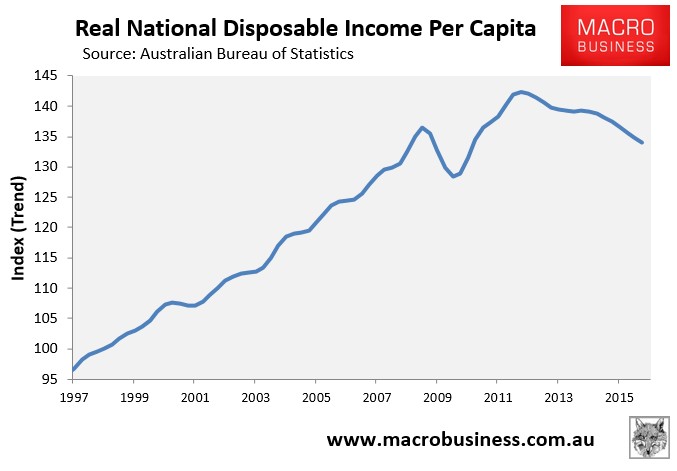
If you want more proof of the fallacy of this city-centric view, consider the trade data for NSW and VIC, where exports have stalled just as their respective trade deficits have exploded:
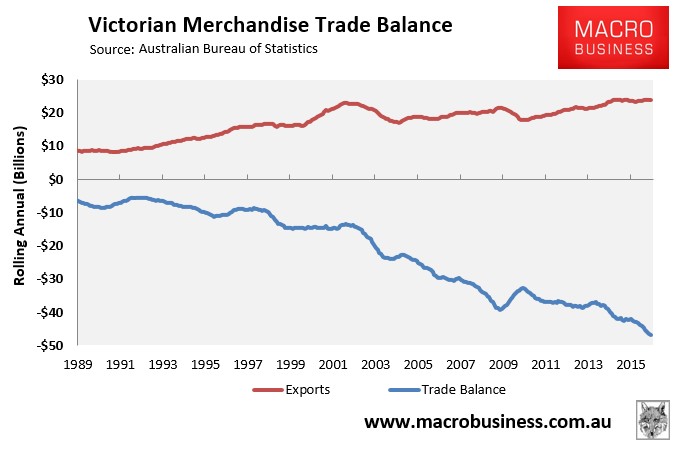
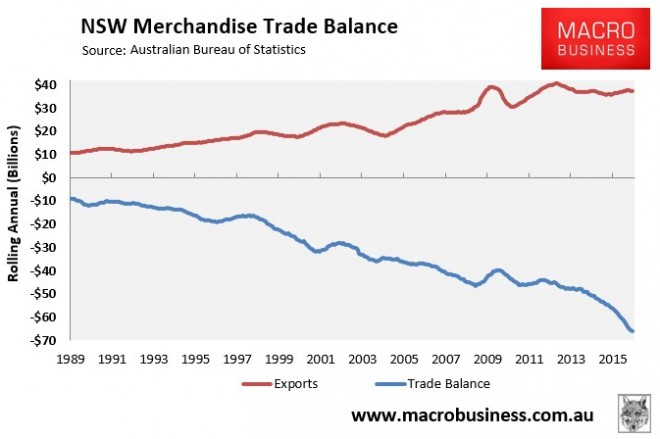
I know what you are thinking: what about services trade? Well, I don’t have the state breakdown, but the overall services trade balance is firmly in deficit, suggesting that it would not improve the trade picture in either state:
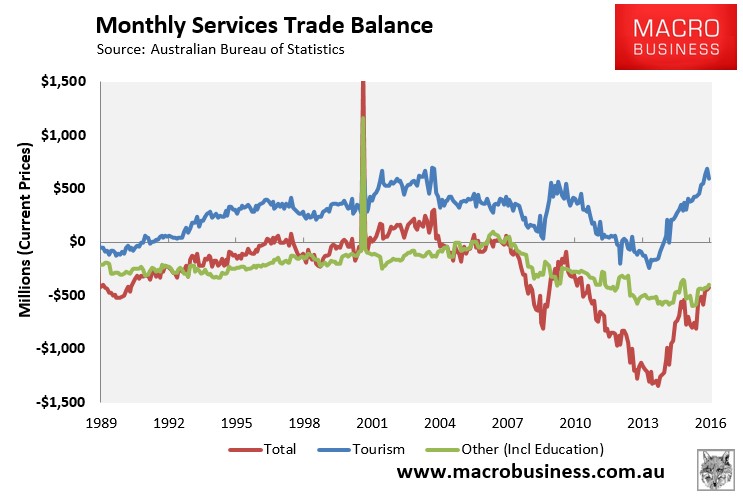
And let’s not forget the massive explosion in Australia’s net foreign debt on the back of the banks mammoth borrowing from offshore, which has funded the rise of the wondrous “city”. This has delivered massive rents to the FIRE economy at the expense of everyone else.
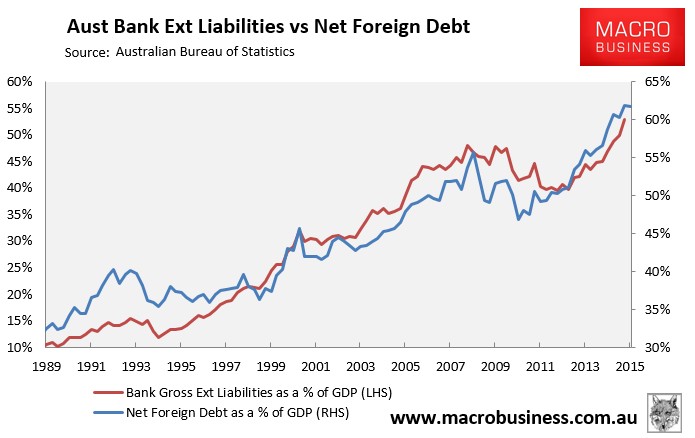
Again, Australia’s housing policies and compulsory super system have transferred economic rents to the CBD from elsewhere. And diverting yet more of the nation’s capital into the CBD will only exacerbate this outcome. The financial sector (and other services industries) would obviously be key beneficiaries (e.g. via higher land/house prices and mortgage debt), but this would come at the expense of the broader economy.
Put simply, bigger CBDs mean a less competitive national economy and a wider current account deficit – hardly a desirable outcome, an economy that is more unbalanced and less sustainable as well, not to mention less equitable.

